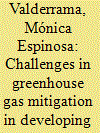|
|
|
Sort Order |
|
|
|
Items / Page
|
|
|
|
|
|
|
| Srl | Item |
| 1 |
ID:
132634


|
|
|
|
|
| Publication |
2014.
|
| Summary/Abstract |
To alleviate the problem of the insufficient reserves of natural gas in China, coal-based synthetic natural gas (SNG) is considered to be a promising option as a source of clean energy, especially for urban use. However, recent study showed that SNG will not accomplish the task of simultaneous energy conservation and CO2 reduction. In this paper, life cycle costing is made for SNG use in three main applications in residential sector: heating, household use, and public transport. Comparisons are conducted between SNG and coal, natural gas, liquefied petroleum gas (LPG), diesel, and methanol. The results show that SNG is a competitive option only for household use. The use of SNG for heating boilers or city buses is not as cost-effective as expected. The biggest shortcoming of SNG is the large amount of pollutants generated in the production stage. At the moment, the use of SNG is promoted by the government. However, as shown in this paper, one can expect a transfer of pollution from the urban areas to the regions where SNG is produced. Therefore, it is suggested that well-balanced set of environmental damage-compensating policies should be introduced to compensate the environmental losses in the SNG-producing regions.
|
|
|
|
|
|
|
|
|
|
|
|
|
|
|
|
| 2 |
ID:
162917


|
|
|
|
|
| Summary/Abstract |
CO2eq emission scenarios for the Colombian transport sector were estimated for 2010–2050. We used a marginal abatement cost approach to assess an emission mitigation pathway. For this purpose, we constructed a carbon emission accounting model linking travel demand to vehicle stock, fuel consumption, and emissions for the Colombian transport sector. Actions related to energy efficiency, fuel switching, new engine technologies and modal change were considered. The analyzed measures have the potential to reduce the cumulative emissions by 8% and 18% under the BAU scenario through 2030 and 2050, respectively. Mitigation costs are high and imply annual capital costs that range from 0.5% to 4% of the national GDP. Gains in efficiency as well as synergy with other sector objectives might help justify some of the actions in financial terms. Non-technological actions, such as high public transit participation in the urban modal share and reorganization of the freight system, play a significant role in attaining low-carbon transport systems in Colombia.
|
|
|
|
|
|
|
|
|
|
|
|
|
|
|
|
| 3 |
ID:
109424


|
|
|
|
|
| Publication |
2011.
|
| Summary/Abstract |
This study examines the historical relation between carbon dioxide emission and output growth in the Swedish pulp and paper industry from 1973 to 2006. We find that the industry achieved an 80 percent reduction in carbon dioxide emission, where most of the reduction took place before the implementation of active climate policy in 1991. Foremost energy substitution and also efficiency improvements contributed to the reduction. Growing prices of fossil fuel due to market price change and taxes and subsidies, explains most of the efficiency improvements and substitution. The study finds that energy transformation was coinciding with ongoing structural change in the industry during the 1970s and 1980s as well as a strong period of environmental adaption. We therefore suggest that the oil reduction was reinforced through the dynamics between the energy issue and an overall renewing process of the industry. This suggests a need to coordinate climate and environmental policy measures with the long-term industrial dynamics of structural change.
|
|
|
|
|
|
|
|
|
|
|
|
|
|
|
|
|
|
|
|
|